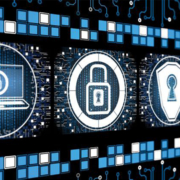2023 Trends in Cybersecurity
Cybersecurity is a never-ending game of chess in which players constantly try to outsmart each other. The cybersecurity chessboard is constantly shifting, and new threats emerge every day. To stay one move ahead of cybercriminals, you need to understand the fast-moving trends in cybersecurity.
Trends in Cybersecurity to Watch For in 2023 and Beyond
| Trends in Cybersecurity | ||
| Trend | Problem | Solution |
| Artificial Intelligence | Cyberattackers can employ AI to:
– analyze vulnerabilities, study network structures, and identify potential targets – automate and optimize their attack methods – develop polymorphic malware – boost social engineering scams |
Cybersecurity pros can use AI to:
– analyze attack methods, detect anomalies, and predict potential threats – develop effective strategies to stay ahead of cybercriminals – predict and stop malware attacks – automate scanning for vulnerabilities in software, systems, and networks |
| Supply Chain Attacks | Cyberattackers can exploit supply chain vulnerabilities to:
– gain unauthorized access |
Cybersecurity pros should:
– conduct risk assessments of supply chains – add security mandates to contracts – monitor supply chain partners’ security – verify the integrity of software |
| Ransomware | Cyberattackers can launch double-extortion attacks by:
– stealing sensitive data |
Cybersecurity pros should:
– back up data at different locations or use cloud-based storage – keep software up to date – conduct anti-phishing training for employees – implement multifactor authentication |
| IoT Security | Cyberattackers can target industrial control systems to:
– cause physical damage |
Cybersecurity pros should:
– conduct risk assessments of ICS and other IoT devices – update software regularly |
Artificial Intelligence: Attacker
ChatGPT is the new kid on the block and is primed to take on any chess opponent while raising the stakes of the game in the process. While the impact of artificial intelligence is mostly positive, bad actors can also use it to evade cyber defenses and boost cyberattacks.
Just like chess players strategize their moves, cyberattackers use AI to devise sophisticated attack strategies, analyze vulnerabilities, study network structures, and identify potential targets. Attackers can use AI to automate and optimize their attack methods, increasing their chances of success while minimizing detection and response times.
Cybercriminals also use AI to enhance their social engineering scams. With AI, they are able to create fake emails, texts, and social media posts that look like they’re from legitimate sources. Scams have become less “click here to win a free Bahama vacation” and more subtle and personalized (and therefore easily clickable). They trick the victim into clicking on malicious links or downloading malware-laden files, resulting in an infection that spreads throughout the network and steals sensitive data. Attackers can even use AI to develop polymorphic malware that constantly changes its identifiable features to evade detection.
Artificial Intelligence: Defender
At the same time, cybersecurity professionals are using AI to develop effective defensive strategies to stay ahead of cybercriminals. In a time of exponential and rapid change, cybersecurity professionals have learned the truth to the saying “if you can’t beat them, join them.” These defensive strategies are comparable to the “castling” chess move where the king is moved with the knight to a safer position, protecting it from potential attacks. Oftentimes, protecting the king isn’t about moving the king away from danger, but rather putting barriers in place between the king and such dangers. AI can be that knight in shining armor as long as we know its abilities, rules, and limitations.
Cybersecurity pros can develop AI-powered antivirus and intrusion detection systems to detect and block sophisticated malware, including zero-day attacks. AI can also be used to analyze network traffic, system logs, and user behavior to identify patterns and anomalies indicative of cyber threats. And AI can automate scanning and assessing vulnerabilities in software, systems, and networks.
Supply Chain Attacks
Nation-state actors and cybercriminals are exploiting vulnerabilities in the supply chain to gain unauthorized access, gather intelligence, disrupt operations, and compromise data of target organizations. These attacks compromise the integrity, confidentiality, or availability of products and services.
To protect against supply chain attacks, organizations should:
- Conduct a comprehensive risk assessment of the supply chain to identify potential vulnerabilities and weak points
- Establish security requirements and include them in contracts and agreements with suppliers
- Clearly communicate expectations regarding security measures, controls, and incident response procedures
- Monitor and audit supply chain partners to ensure compliance with security standards
- Verify the integrity of software and firmware used in the supply chain to ensure they come from trusted sources and are regularly updated with security patches
Both supply chain security and chess require strategic thinking, proactive approaches, consideration of interdependencies, long-term planning, and the ability to adapt to changing circumstances.
Double-Extortion Ransomware
From multinational corporations to local school districts, ransomware attacks continue to threaten organizations of all sizes. Ransomware encrypts a victim’s files, making them unusable. A ransom payment is then demanded for the decryption key.
In recent years, ransomware attacks have evolved to include the threat of exposing sensitive information if the ransom is not paid—a so-called double-extortion attack. The attackers steal the data before encrypting it so they can add the return of data to their ransom demands. It’s like a chess move called a “fork,” in which a player attacks two or more pieces at once.
To prevent ransomware attacks from succeeding, organizations should:
- Back up their data at a remote location
- Ensure data backups are not directly accessible from the network
- Keep software updated and apply security patches immediately
- Conduct anti-phishing training for employees, because phishing emails and text are often the entry point for ransomware attacks
- Implement multifactor authentication to ensure attackers can’t use stolen passwords to deploy ransomware
Internet of Things Security
With more and more devices connected to the internet, the attack surface for cybercriminals is expanding rapidly. In Internet of Things (IoT) attacks, cybercriminals target vulnerable devices, such as smart thermostats and security cameras, to launch more significant attacks.
Industrial control systems (ICS), which control infrastructure, are particularly vulnerable to IoT attacks because of their age and criticality. Successful ICS attacks can result in physical damage, disruption of services, safety hazards, financial losses, and economic impacts.
The best way to protect these systems is with a multilayered defense, which includes:
- rk segmentation
- Regular ICS patching and updates
- Security awareness training
- Intrusion detection systems
- Robust cyber security policies
Chess players assess the risks and potential consequences of each move before acting. Similarly, IoT security requires risk assessments at several levels, including device security, data privacy, network integrity, and communication protocols.
IoT ecosystems can be protected by implementing strong network security measures, updating software regularly, deploying robust access controls, and conducting security awareness training for employees.
These trends, from AI and supply chain security to ransomware attacks and IoT security, illustrate just a few examples of the moves being made by attackers and defenders. By staying ahead of trends in cybersecurity and adopting new strategies and technologies, organizations can protect themselves from cyberattacks and emerge victorious in the ongoing game of cybersecurity chess.
___________________________
John Sileo is an award-winning cybersecurity keynote speaker who has entertained and informed audiences for two decades. He can help your organization understand and stay ahead of trends in cybersecurity. He is proud to have spoken at the Pentagon and Amazon, written four books on cybersecurity, and been inducted into the National Speakers Hall of Fame. He has appeared on 60 Minutes, NBC, ABC, Fox, CNN, Rachael Ray, and Anderson Cooper. John’s work has been quoted and published in The Wall Street Journal, The Washington Post, USA Today, and Kiplinger’s.
Looking for a customized speech to make your next event unforgettable? Call 303.777.3221 or fill out our contact form to connect with Sue, our business manager extraordinaire. She’ll work with you to brainstorm ideas and explore how John can tailor his speech to fit your needs perfectly.






 sileo.com
sileo.com 




